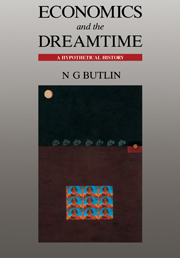Book contents
- Frontmatter
- Contents
- Preface
- Acknowledgements
- Figures
- Maps
- Tables
- Introduction
- Part I The palaeoeconomic history of Aboriginal migration
- Part II Development, structure and function of Aboriginal economy
- Part III Disease, economics and demography
- 12 Introduction
- 13 The problem of an exposed population
- 14 Re-estimating precontact populations
- 15 Turning the models around
- Part IV The establishment of a bridgehead economy: 1788–1810
- Part V The takeover process: 1788–1850
- Bibliography
- Appendix 1 Preliminary model/checklist of Aboriginal migration to Australia
- Appendix 2 NOAA depth contour maps
- Index
15 - Turning the models around
Published online by Cambridge University Press: 06 July 2010
- Frontmatter
- Contents
- Preface
- Acknowledgements
- Figures
- Maps
- Tables
- Introduction
- Part I The palaeoeconomic history of Aboriginal migration
- Part II Development, structure and function of Aboriginal economy
- Part III Disease, economics and demography
- 12 Introduction
- 13 The problem of an exposed population
- 14 Re-estimating precontact populations
- 15 Turning the models around
- Part IV The establishment of a bridgehead economy: 1788–1810
- Part V The takeover process: 1788–1850
- Bibliography
- Appendix 1 Preliminary model/checklist of Aboriginal migration to Australia
- Appendix 2 NOAA depth contour maps
- Index
Summary
How can we exploit these approximations to estimate possible or plausible precontact Aboriginal populations? If we have reasonable estimates of remnant populations prior to 1850, we can reverse the models and project backwards from these dated estimates to a 1788 base. There are fortunately some numbers, particularly for Victoria and Van Diemen's Land, but much less completely for New South Wales. In Van Diemen's Land we have the official 1818 estimate of ‘about 7000’ and by the early 1830s a few hundred. For Victoria, there is an array of numbers but essentially they apply to the early 1840s. In New South Wales, estimates for coastal areas are also available for the early 1840s. Though we concentrate on these areas here, it is relevant in extending the picture to the whole of Australia that early estimates are available for parts of Queensland and Western Australia.
Van Diemen's Land
Van Diemen's Land is the least significant and can perhaps be disposed of quickly. Radcliffe-Brown (1930) opted for a precontact population of 2–3000. Rhys Jones (1970) has raised this number to 5000. The Statistics of Van Diemen's Land estimated a current population of 7000 in 1818 and G. A. Robinson (in Radcliffe-Brown, 1930) projected a precontact number of about 7–8000. Given the extensive sealing around the island from the later 1790s, its size, and the penetration of settlement by 1818, it is not implausible that the colonists had a reasonably good impression of prevailing numbers by 1818.
- Type
- Chapter
- Information
- Economics and the DreamtimeA Hypothetical History, pp. 133 - 140Publisher: Cambridge University PressPrint publication year: 1993



